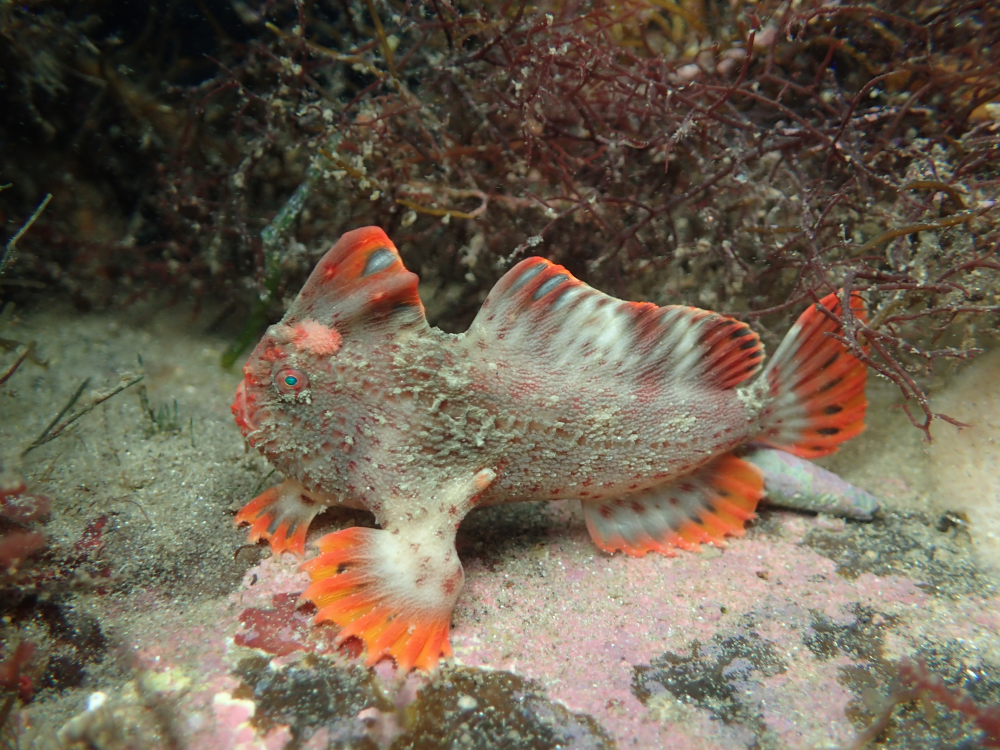Behold, the rarest fish in the world! The red handfish, Thymichthys politus, is known from just two small patches of reef off the coast of Tasmania, thought to be home to around 100 adults. Habitat degradation and climate change have threatened them with extinction, but thanks to a breeding program, they welcomed 21 hatchlings in 2023.
It was the second time red handfish have been successfully bred in captivity, and gave rise to a new generation that represented a quarter of their wild population. Mother handfish will care for their eggs until they hatch after around 50 days.
The goal? To release these babies into the wild and bolster the wild breeding population. However, before they can swim in the big blue, they’ve got to graduate handfish school.
“Handfish school is an initiative funded by our supporters at Foundation for Australia’s Most Endangered species, and its purpose is to develop ‘street smart’ skills for handfish that have been raised in captivity,” University of Tasmania handfish experts Dr Jemina Stuart-Smith and Dr Andrew Trotter told IFLScience.
“It includes introducing more complex habitats, other species, and conditions that they’re likely to encounter in the wild. It’s really an acclimation period that provides an opportunity for fish to learn natural behaviours such as finding food, seeking shelter, interacting with conspecific species, and navigating in the sea. The purpose is to increase their chances of survival upon release.”
Even getting to the stage of having eggs was a tricky task for the red handfish team, as there’s a lot we still don’t know about the world’s rarest fish. For instance, it was only recently that we learned how to tell the males and females apart, which – as you can imagine – is a handy thing to know when trying to pair up possible mates. It’s also unclear exactly what environmental clues these fish use to know when it’s breeding season, but the team has seen two successful captive breeding events nonetheless.
The difficulties don’t end once the wee bundles of joy hatch, either. Coming out as fully-formed 10-millimeter (0.4-inch) handfish, feeding and caring for them is a challenge in itself.
“If you’ve never seen a handfish before,” reads a quote on the Handfish Conservation Project website, “imagine dipping a toad in some brightly coloured paint, telling it a sad story, and forcing it to wear gloves two sizes too big.”

The species’ capacity to thrive in the wild depends on the specific habitat they need to breed.
Image courtesy of Tyson Bessell
If that doesn’t sell you on these critters, frankly I don’t know what will, but by Stuart-Smith and Trotter’s accounts, they’ve got great personalities, too.
“They’re quirky little creatures that seem to be quite social – they’re often found together in the wild. They’re also ambush or ‘sit-and-wait’ predators that live on the seafloor, so they spend most of their time standing still. But they also use fin displays in communication, which is often directed at us humans, although we don’t understand what they’re trying to tell us!”
Restoring the species won’t be easy, as unless the seaweedy habitat they need to breed is restored, and stays that way, the species will remain vulnerable. However, bumping up their wild populations with recruits from the captive breeding and release program is a step towards bringing red handfish back from the brink, each ridiculous hatchling representing a step in the right direction.
“Handfish represent part of the natural ecosystem, and are endemic to Tasmania,” concluded Stuart-Smith and Trotter, “so losing them would mean losing part of our unique natural values and biodiversity.”
For more information on red handfish, visit the Handfish Conservation Project website, or check out the Institute for Marine and Antarctic Studies. Red handfish work is made possible through funding from the Foundation for Australia’s Most Endangered species, the Australian Government’s Department of Climate Change, Energy, the Environment and Water (DCCEEW), and the Institute for Marine and Antarctic Studies at the University of Tasmania.
Source Link: The World’s Rarest Fish Is Making A Comeback, One Ridiculous Baby At A Time